Amalie Sara Colquhoun
Amalie Sara Colquhoun (20 March 1894 – 16 June 1974) was an Australian landscape and portrait painter who is represented in national and state galleries. In addition to painting landscapes, portraits and still lifes, Colquhoun designed and supervised the construction of stained glass windows for three of Ballarat's churches, St Andrew's Kirk, Lydiard Street Uniting Church and Mount Pleasant Methodist Church. She studied in both Melbourne and Sydney, exhibited in England and Australia and taught in the school she started with her husband in Melbourne.[1]
Amalie Sara Colquhoun | |
|---|---|
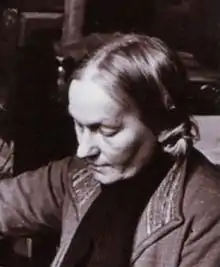 Amalie Colquhoun in 1945 | |
| Born | Amalie Sara Field 20 March 1894 Murtoa, Victoria |
| Died | 16 June 1974 (aged 80) East Melbourne, Victoria |
| Nationality | Australian |
| Known for | Painting, Educator |
| Spouse(s) | Archibald Colquhoun (m. 1931) |
Biography
She was born Amalie Sara Field in Murtoa, a town in the Wimmera region of Victoria, Australia to parents Alfred Francis Field, a blacksmith, and Louisa Caroline, née Degenhardt, both Australian born. They moved to Ballarat in 1904 where Amalie studied drawing and design at the Ballarat Technical Art School, becoming the Art Mistress there in the mid-1920s. She was described by Harold Herbert as one of the most brilliant students to ever pass through the school.[2] She continued to advance her career when the Victorian Education Department supported her study of pottery and stained glass at Sydney Technical College. On returning to Ballarat she started the teaching of pottery at the school. She continued her studies at the well-known Max Meldrum School in Melbourne. She also taught at Melbourne Technical College.[3]
Amalie Field married Archibald Colquhoun in 1931 and they had no children. She died on 16 June 1974 in East Melbourne and was buried in Boroondara cemetery, Kew, with Anglican rites.
Career
In 1927 she was appointed to the Working Men's College in Melbourne, a post which she resigned in 1933.[4] In the same year Archibald Colquhoun started an art school in that city. Amalie Colquhoun was one of Archibald Colquhoun's students and married him in 1931. Up until the time they bought their property at Swinton in Kew, the Colquhouns lived in their Melbourne studios.
Colquhoun and her husband taught for many years and had portraits, landscape paintings, and reproductions of famous sculptures displayed on the walls of the school. Colquhoun was noted for her seascapes painted from their holiday house at Lorne, Victoria. In 1937 they spent a year painting in Edinburgh and London, and exhibited jointly at the Islington Galleries, London.[5] While there they also exhibited with the London Portrait Society.[6] Her husband's 1948 painting of her, Amalie Colquhoun, is in the Art Gallery of New South Wales.[7] The husband and wife frequently exhibited their work together, and were referred to as the two A's.[8] Amalie has been commended for her ability to keep children happy while painting their pictures. She uses a puppet show controlled by her foot, with theatre built by Archie and figures made herself.[8]
In 1950 the Colquhouns closed the school, and in 1954 moved from the city to Kew, establishing a studio and occasional gallery in their home. They continued to paint intensively, particularly landscapes and seascapes reflecting their travels.[9]
I am convinced that everyone must benefit from the study of art. All adults should take some course, even if they do not start until they are 40. Many people may never be artists or make their living by art, but their artistic appreciation can be developed and improved just as a taste for good literature comes with good reading. They get a mental and artistic development that can never achieve in any other way. Often those who seem to fumble at the beginning go much further than those who start with a flash of brilliance that peters out into the ordinary. There are many people teaching art today who should be learning. Every teacher, in fact, should be a student, or the habit of experiment will be lost. It is only be experiment that art can keep on developing.
-Amalie Colquhoun on why everyone should study art, The Herald, 20 December 1933[10]
Honours
In 1949 Colquhoun was a finalist in the Archibald Prize with her work Rosa.[11]
 Amalie and Archibald Colquhoun exhibiting at the Islington Galleries, London
Amalie and Archibald Colquhoun exhibiting at the Islington Galleries, London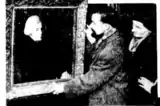 Artists Archibald and Amalie Colquhoun examining a painting at their exhibition
Artists Archibald and Amalie Colquhoun examining a painting at their exhibition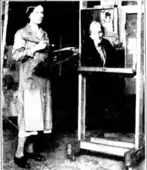 Amalie Colquhoun painting in her studio
Amalie Colquhoun painting in her studio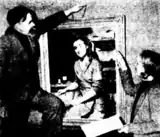 Amalie and Archibald Colquhoun hanging paintings for their joint exhibition
Amalie and Archibald Colquhoun hanging paintings for their joint exhibition Advertisement for a joint exhibition by the Colquhouns
Advertisement for a joint exhibition by the Colquhouns
Exhibitions
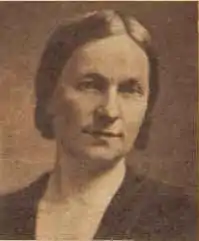
Paintings by Amalie Colquhoun and A. D. Colquhoun
- Athenaeum Gallery, 1934 (catalogue)
- Group exhibition, Athenaeum Gallery, 1934 (catalogue)
- Stair Gallery, 1937 (catalogue)
- Athenaeum Gallery, 1938 (catalogue)
- Seddon Galleries, 1942 (catalogue)
References
- Perry, Peter W (2007). "Colquhoun, Archibald Douglas (Archie) (1894–1983)". Australian Dictionary of Biography.
- "ART". Australasian (Melbourne, Vic. : 1864 - 1946). 24 June 1933. p. 16. Retrieved 18 September 2020.
- Campbell, Di (2005). "Amalie Sarah Feild-Colquhoun (1894-1974) Artist, SMB student and art mistress". Federation University.
- "ARTS MISTRESS RESIGNS". Age (Melbourne, Vic. : 1854 - 1954). 19 December 1933. p. 7. Retrieved 18 September 2020.
- "Let s Talk Of Interesting People". Australian Women's Weekly (1933 - 1982). 13 February 1937. p. 2. Retrieved 18 September 2020.
- "THE London Scene". Sun (Sydney, NSW : 1910 - 1954). 16 May 1937. p. 3. Retrieved 18 September 2020.
- "Amalie and Archibald Colquhoun". julia ritson. 26 July 2011. Retrieved 19 March 2018.
- "Crinolines The Rage: Attics Ransacked And Paris Cabled". Sun (Sydney, NSW : 1910 - 1954). 10 July 1938. p. 8. Retrieved 18 September 2020.
- Goldsworthy, Val (March 2011). "Camberwell History" (PDF).
- "EVERYONE SHOULD STUDY ART". Herald (Melbourne, Vic. : 1861 - 1954). 20 December 1933. p. 19. Retrieved 18 September 2020.
- "Archibald Prize finalists - 1949". Art Gallery of New South Wales. Retrieved 17 February 2018.
Bibliography
- "Design and Art Australia Online." Amalie Sara Colquhoun: Biography at Design and Art Australia Online. DAAO, 1 Jan. 1995. Web. 27 Mar. 2017.
Further reading
- P. and J. Perry, Max Meldrum and Associates (1996).
- Rosalind Gowans, The Colquhoun family of artists, pg. 12, East Melbourne, Aug 2007-Sep 2007.
- H. de Berg, interview with A. D. and A. Colquhoun (typescript, 1965, National Library of Australia).
External links
- An image of Amalie S Colquhoun by A D Colquhoun in Art Gallery NSW
- Amalie Colquhoun: Australian art and artists file, State Library Victoria
